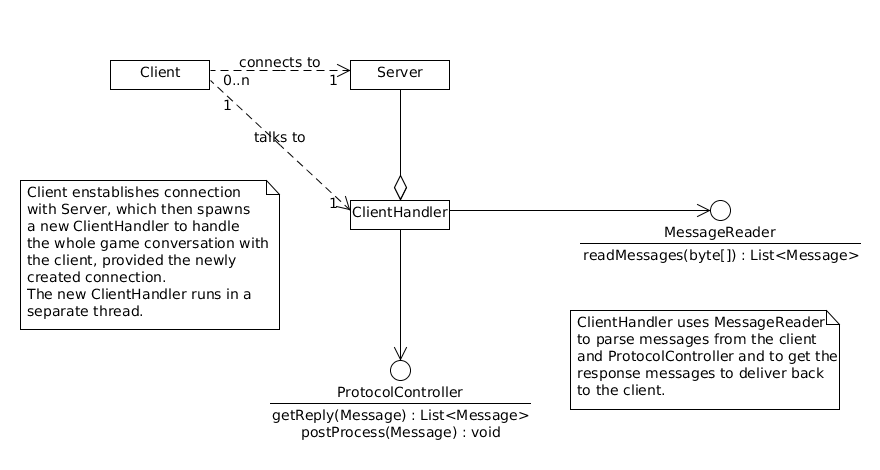How to develop
Developer prerequisites
These are the prerequisites for developers:
- A Java IDE, e.g. Eclipse ™.
- Apache Maven - Maven this is a great build tool which ensures build replicability; you don't need to have a deep understanding of it to use it, it's just enough that you successfully install it.
- TCP/IP - You should be familiar with the basics of client-server communication, namely the TCP/IP protocol stack (and related basic concepts, like sockets).
- Subversion (SVN) - It's essential to work together and it's also quite easy to use.
- Exclusively for reference purposes, it's useful to consult RunUO source code; for this, you'll need a C# IDE: either Visual Studio Express if you're on Windows, or MonoDevelop on Linux (if you're on Ubuntu, I suggest you add the badger repository which provides the latest installer through synaptic package manager).
- Again for reference purposes, bookmark the POL packet reference.
How to get started
Once you meet the prerequisites, check out the sources with SVN:
$ svn co https://juoserver.svn.sourceforge.net/svnroot/juoserver juoserver
and build it:
$ cd juoserver
$ mvn clean install
...
[INFO] ------------------------------------------------------------------------
[INFO] BUILD SUCCESS
[INFO] ------------------------------------------------------------------------
You are now able to start the server.
Import the project into Eclipse
If, like me, you're using Eclipse, I suggest you install the following plugins:
- m2eclipse to import the project,
- subclipse to be able to check out and commit with SVN from Eclispe.
Once you have them, you can import the project using m2eclipse and keep synchronized with the SVN repository with subclipse.
Run the server from within the IDE
You can of course run and debug the server from your IDE, executing the net.sf.juoserver.networking.Server class.
State of the project
The project is still very alpha, it still needs crucial features and structure.
These are the features that have been included so far.
I'll now briefly describe the main parts composing the system, as it is now.
Network
This is the network architecture of the system:

It is nothing more than an ordinary server with clients running on separate threads.
Controller
The server controller is implemented by the Controller class, which manages two aspect of the server itself:
- By means of ProtocolController interface, it acts as a protocol controller, managing a basic request-reply mechanism (synchronous semantics),
- By means of the IntercomListener interface, it is able of being connected to the other clients' controllers, thus implementing inter-client communication (asynchronous semantics).
Model
The model has no precise architecture, yet. It is rather a "flat" aggregation of classes, notably:
I plan to add classes and interfaces as they become needed. One important characteristic of the model is that it is completely oblivious of the controller and the other layers, which, in turn, depend on the model to implement their concerns (e.g., the controller uses Mobile to notify clients of approaching characters).
Road-map
This is a collection of objectives. Having time, I'd like to turn these into tasks within the Sourceforge issue tracker. The lists are partial, there are surely a LOT more things to be done!
Short-term objectives
Add these features:
- Improve the dragging & dropping of items:
- Now it works only to and from the ground,
- Do it also to and from any container (e.g. your backpack),
- Enable the drag & drop between characters.
- Notify clients also on login when necessary (by now they're notified only when moving the characters),
- Implement a complete (though simple) combat scenario (this is more a user story),
- Introduce scripts. They will designed according to the active-object pattern, meaning the scripts will run in the core's thread.
- Implements LOS (line of sight).
Long-term objectives
They include, most important first:
- Add persistence (I'd like not to use a relational DB, but we'll see...) and read mobiles, items, accounts, etc from the chosen persistent store,
- Improve inter-clients notifications - is the current pattern suitable for the task? By now a simple observer is employed, but as simple as it is there are already signs of its being unfit, because these different semantics are needed:
- Point-to-point (when having to notify a single client),
- Topic-like, when a character must be visible to a group of other characters.
Maybe the observer pattern is not the best for this, because it forces the controller to add checks like (point-to-point):
@Override
public void onEnteredRange(Mobile entered, Mobile target) throws IntercomException {
if (!target.equals( mobile )) {
return; // Point-to-point semantics
}
...
}or (topic):
@Override
public void onOtherMobileMovement(Mobile moving) throws IntercomException {
if (moving.equals( mobile )) {
return; // Ignore self-notifying messages
}
....
}I'd much more like it if it this filtering was done declaratively, rather than imperatively (I've done something like this using Prolog, so I could just use it).
Also, the Intercom class is used statically, which is not so cool.
- Implement system notifications (i.e., messages on the lower part of the client's screen),
- Add a CLI (command line interface) acting like another sort of client,
.. all of this while not putting in any custom policy about skills and so on: I want to keep as abstract and simple as possible.
Spring
Among the aims of this project is learning, therefore I decided to adopt the Spring Framework for dependency injection (and probably not only).
Consequences of adopting Spring:
- Because Spring IoC framework injects dependencies after the objects have been created, classes constructors can no longer rely on injected dependencies. Consequently, the init() methods cannot be called by constructor: it will belong to the classes' interface (this is an up-side).
- The dependency injection happens only when the creation of the objects is performed by the Spring framework - i.e. you cannot have a class injected with a dependency if you create that class with the new operator: it all has to start by calling a getBean() method on the Spring application context.
